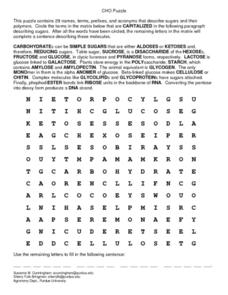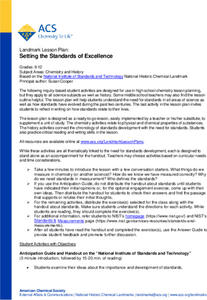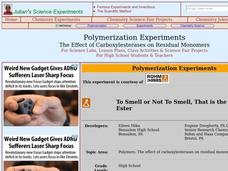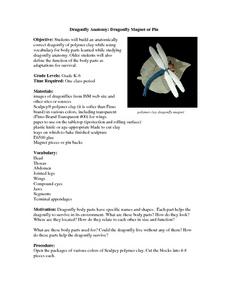Curated OER
# 18 Determination of the Set Time for Epoxy Adhesive
Students recognize epoxy glue formation as two part polymerization (usually the curing agents act as co-monomers). They monitor the reaction by the changes in viscosity of the reacting mass, the temperature rise and fall, and the...
Cornell University
The Making of Macromolecules
Compare and contrast macromolecules made from the same elements. Young scholars learn how the structure of a molecule has as much influence on a compound as the elements in the molecule. They experiment with molecular model kits to...
Curated OER
Addition Polymerization: Preparation of Polystyrene Using Two Types of Initiators
Advanced chemistry classes compare the polymerization of styrene using two different initators: benzoyl peroxide and aluminum chloride. Once they synthesize polystyrene, they compare the two producet for melting point and density. There...
Curated OER
Polymerization of Nylon
Students demonstrate how to create polymers from monomers. In this chemistry lesson, students describe the properties of the new nylon produced. They research about a polymer they chose.
Curated OER
Polymer Physics on the Playground
Students investigate what materials allow them to slide down a slide the fastest. They set up test procedures and carry out an experiment.
Curated OER
What is Plastic?
Students experiment with plastics. In this what is plastic lesson, students make a simple polymer and discuss recycling. Students identify various types of plastics.
Curated OER
CHO Puzzle
In this sugar worksheet, students complete a puzzle by circling all the words in the puzzle related to sugars. The remaining letters in the puzzle create a sentence describing the sugar molecules.
Beyond Benign
Writing the Principles
What is the difference between chemistry and green chemistry? The first lesson of the 24-part green chemistry series introduces scholars to its 12 principles. The tendency is toward nontoxic materials and sustainability.
American Chemical Society
Setting the Standards of Excellence
A number doesn't have much meaning without a standard of reference. Learners read about the history of developing standards to measure chemical and physical properties and complete reading guides to process the information. They focus on...
Curated OER
Mystery Powders
Learners describe the physical properties of polymers. In this chemistry instructional activity, students experiment on different polymer powders and identify each one of them. They record their observations and share them to class.
Curated OER
Build a Better Bouncer
Students create the best bouncing ball possible using basic substances. In this chemistry lesson, students describe the effect of additives to polymers. They graph and analyze their results.
Curated OER
How Shocking
Learners describe the characteristics of polymers and rubbers and how they improve human lives. In this shock activity students build a shock absorbing structure using different polymer materials.
Curated OER
Bouncing Balls
Students create a polymer to demonstrate its properties and develop an awareness of the wide variety of uses for polymers.
Curated OER
Goofy Putty
Students examine mixtures and solution properties by making a borax polymer. In this chemical reactions lesson, students make a putty out of borax solution mixed to create a polymer.
Curated OER
Critter? Growth
Learners identify and use the elements of the scientific inquiry to solve problems. They explain concepts about the structure and properties of matter. Pupils write an explanation of polymers and how the characteristic of polymers...
Curated OER
The Miracle Fish: Learning to Design an Experiment
Students develop procedures to explore the behavior of fish. In this scientific experiment lesson students from a hypothesis, write a question, identify different variables and controls in their experiment.
Curated OER
Polymerization Experiments
Students explain the process of polymerization. In this chemistry instructional activity, students produce carboxylesterase in the lab. They test its effectiveness in removing the by-product odor.
Curated OER
Physics on the Playground
Young scholars investigate friction on a playground slide. In this force and energy lesson, students will predict, plan, and implement a scientific investigation to the problem; What materials will allow me to slide the fastest down a...
Curated OER
Materials and Process: Plastics
Students investigate the development of plastics in the twentieth century. In this plastics lesson, students complete image based discussion activities for the pictures and methods of polymers. Students create an object timeline...
Curated OER
An Introduction to DNA (PowerPoint)
Students are introduced to the structure of DNA, nomenclature, and the chemical basis for DNA through a PowerPoint lecture. PowerPoint is included as well as review questions over the presentation.
Curated OER
Nanofibers on Your Clothes
High schoolers relate the presence of nanofibers in clothing to its ability to repel stains. They observe and contrast the characteristics of nanofiber, Scotchguard treated, and regular fabric then test the stain resistance of each...
Curated OER
Come Shine with Us: Floor Polish Testing and Industrial Science To Teach Critical Thinking
Young scholars discover that science relates to everyday life and see testing procedures used in an industrial laboratory. Students compare various brands of household and industrial floor polishes for specific criteria.
Curated OER
Dragonfly Anatomy: Dragonfly Magnet or Pin
Students build anatomically correct dragonflies of polymer clay, use vocabulary for body parts, and define the function of the body parts as adaptations for survival.
Curated OER
Diaper Challenge
Young scholars compare the absorbency of a regular diaper and a swim diaper in fresh water and salt water. In this absorbency lesson plan, students mass the diapers and place them in water and determine the change in mass. They do the...

























